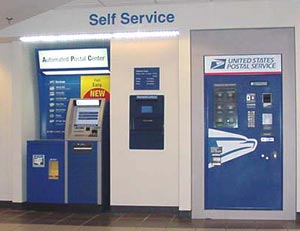Article
Q&A: Cutting in line at the Post Office
Waiting in line is one of the enduring frustrations of modern life. Whether it is for the chance to purchase baseball tickets or get a driver's license renewed, the very act of standing in line can create stress and ruin a good mood.
March 28, 2005
Waiting in line is one of the enduring frustrations of modern life. Whether it is for the chance to purchase baseball tickets or get a driver's license renewed, the very act of standing in line can create stress and ruin a good mood.
Reporter James Bickers recently spoke with Janet L. Webster, manager of retail service network and access management for the United States Postal Service, about the USPS's sharp new Automated Postal Centers.
Q: How long has this project been in development?
A: The project itself started from a research and development perspective in 1997, and it became a pilot kiosk project in May of 1999. It was a pilot R&D effort from May of 1999 until April of 2004.
Q: What were some of the motivating factors in developing a self-service postage kiosk?
A: We were very focused on customer convenience. We want to be quick, easy and convenient for our customers, and we believe that kiosk technology is a way to extend access so that customers that want to do business with us but cannot make it in until the post office has closed would have an opportunity. Our focus was entirely on customers - we have had operational benefits from these machines, but our focus was on how to give our customers products and services, at their convenience.
 |
The Postal Service's new Automated Postal Center |
Q: How many of the units have been deployed so far? What is your timetable for future deployments?
A: We have 2,500 deployed - we started our production deployment in April 2004, and we completed all 2,500 in November of 2004. Our goal was to get them out there for the holiday season. Right now, we're in the process of developing the justification to do another buy - we have a special process that we go through in the postal service to get authorization to get funding.
Q: Any feedback from the field on how customers are taking to them?
A: We did some informal research with customer intercepts, which has shown that 98 percent of the customers like the machine, feel that it's easy to use and they will use it again. Employees are also giving us feedback from both employee and customer perspective, and it's positive in both cases.
Q: What is the technology behind them?
A: The APC itself is based on ATM technology, so the bulk of the machine is an ATM device that was made by Wincor. Our primary provider on this is IBM, and the postal service has added into the ATM technology the scale capability, to be able to weigh packages. We did have to do some additional hardware.
 |
Since the APC does not feature a bill acceptor, Webster said they are only installed in locations that have an existing self-service vending machine. |
Q: The machines accept debit and credit cards only. Why no bill acceptors?
A: That's a really good question. In our market tests, we actually started with debit, credit and cash. Our number one problem - and a problem in this situation means downtime - was bill acceptors. They get dirty really fast, which then means someone has to take care of the machine, which then means work hours. From that perspective, it became very costly. We found in our research that our customers initially were not pleased that we had taken bill acceptors off, so when we went back out, we made sure that these locations had a traditional vending machine that does accept cash.
Q: Is the software 100 percent custom?
A: It's based on our POS software at the counter. It means consistency to the customer, and it means cost-effectiveness for us. The APCs are part of the internal network. It's a self-service version of what is at the traditional retail counter.
Q: How "goof-proof" is the interface?
A: The original development for the market test had a whole lot of research behind it. We talked to the company that had developed the ATM interface, and we got a lot of feedback on how to make it intuitive. We also did some customer focus groups to make sure it was intuitive - we talked to the customers and make sure it made sense to them. We've also had individuals from the Access Board (a federal agency that enforces accessibility standards) look at our screen. We've tried to take every step that we possibly can to have it looked at for ease of use, and I believe we've passed with flying colors.
Q: Are these cost-savers for the Postal Service, or are they chiefly being provided as a means to shorten lines and free up personnel?
A: Our main drive is the customer, and the quick, easy convenient access. That also goes to wanting to reduce any kind of wait time in line, as a customer convenience. The APC is able to take transactions off the counter; that then frees up our associates to be able to work with customers that really do need them, that have more complex transactions that need face-to-face interaction. Customer satisfaction is what is driving this, but there is a benefit there of being able to be operationally more effective.
Related Media
SoftwarePresented ByPROVISIO LLC
Presented ByPROVISIO LLC










